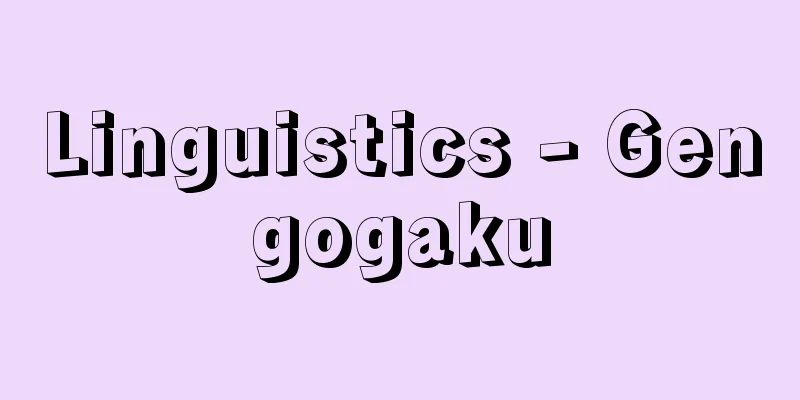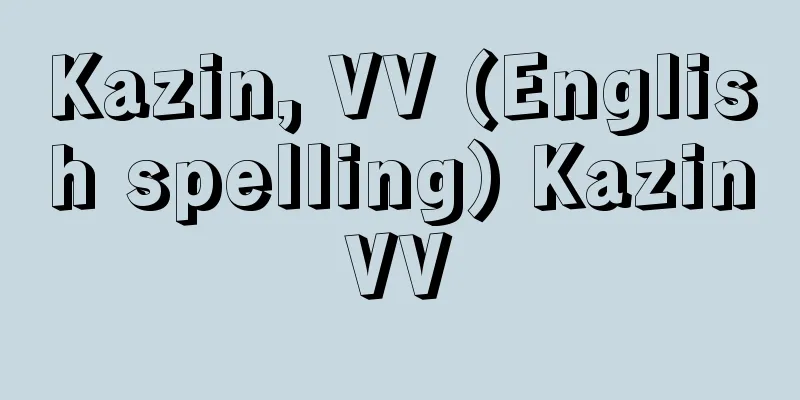Linguistics - Gengogaku

|
The scientific study of human language. Unlike linguistics, which has practical purposes, its aim is to elucidate language itself. Although it is often misunderstood, linguistics does not only deal with ancient languages or etymologies, but covers both the past and the present. It is actually more advantageous for research to focus on modern languages that can be directly observed, and it is easier to get closer to the essence of language. There is general linguistics, which studies languages broadly, and individual linguistics, which studies individual languages, and Japanese linguistics is one type of individual linguistics. [Tetsuya Kunihiro] A brief history of linguisticsConsiderations about language can be seen as early as the 5th century BC in Greece. At that time, grammar descriptions were also made, but classical philology was the mainstream. There was also a long-running debate about whether the relationship between words and the things they refer to was natural or simply customary. The excellent "Sanskrit Grammar" written by Panini of India in the 4th century BC is said to be unparalleled to the present day in terms of the comprehensiveness, consistency, and conciseness of its descriptions. In addition, "Grammar Port-Royal" published in France in 1660 was an excellent attempt at universal grammar, but there has been no further development. In modern times, generative grammar, founded by N. Chomsky, is connected to "Grammar Port-Royal" in that it seeks the universality of language. After the period of Latin dominance in the Middle Ages and the Renaissance, attention began to be paid to languages outside of Europe, and in the 18th century, the existence of the ancient Indian language Sanskrit was noticed. European linguists were amazed by the similarities between Sanskrit and Greek and Latin, and in the 19th century, they began to establish comparative Indo-European linguistics. It began with the insight that the languages distributed from India to Europe may have branched off from a common source, a language that has since disappeared and is no longer recorded. In the 19th century, linguistics was almost exclusively limited to comparative linguistics, the historical study of language, and there was a trend toward linguistics, or historical linguistics. In the 20th century, Swiss linguist Ferdinand de Saussure emerged and argued that language research can be divided into diachronic methods, which deal with historical changes, and synchronic methods, which deal with the state of a certain period of time. He advocated that synchronic research should take precedence, in the sense that diachronic research can only be achieved if synchronic research is conducted in each period, and this marked the beginning of the development of linguistics in the modern sense. Saussure's synchronic state includes the important concept that language is a structure, which enabled the dramatic development of modern linguistics. Alongside Saussure's structuralism, structural linguistics, centered around L. Bloomfield, also developed in the United States, and great strides were made in elucidating phonetic structures. However, because he placed too much emphasis on objectivity and refused to use data obtained through introspection, such as meaning, in the course of the analysis, his analysis of syntax was limited to revealing the distribution of superficial forms, and he was completely unable to start on semantic research. To break through this impasse, Chomsky proposed generative grammar in 1957. This took grammatical intuition into account from the start, and, in contrast to Bloomfield's thorough inductivism, he presented a deep syntactic analysis by taking a deductive approach. Chomsky's theories were developed one after another, but at the same time they had a strong influence all over the world. Linguistic research can be broadly divided into formalist and functionalist. Formalism seeks to elucidate the mechanisms of language itself, and the research of Saussure, Bloomfield, and Chomsky falls into this category. In contrast, functionalism aims to clarify how language is used in specific situations and contexts. In order to clarify linguistic phenomena in their entirety, research from both of these perspectives must come together. While functionalist research has been conducted to some extent for some time, it has suddenly become active since around 1970 in the form of sociolinguistics and pragmatics. Linguistics research in Japan dates back to the late 18th century, when Motoori Norinaga was active. In the Meiji era, European linguistics was introduced, marking the beginning of modern linguistics. Since then, Western linguistics has continued to be introduced, but at the same time, Japan's own unique linguistics has also begun to develop, and in recent years the results of this work have been compiled in "Japanese Linguistics" (8 volumes) edited by Hattori Shiro et al. [Tetsuya Kunihiro] Research FieldLanguage is a mechanism for transmitting meanings primarily through sounds and secondarily through letters. Looking at this entire process, the speaker first thinks of the meanings he wants to convey to the other person, converts them into an appropriate linguistic expression, and then activates the vocal organs to emit sound into the air. The sound reaches the listener's ears as vibration waves, where it is analyzed by the language center of the brain and the original linguistic expression is restored. At the same time, the listener interprets the meanings the speaker intended to convey by inferring them, taking into account the speaker's facial expressions and gestures obtained through vision, the surrounding conditions, and the knowledge of the universe that both parties share. Specialized fields of research can be established for each of the above communicative behavior processes. However, the difficulty of research varies greatly depending on the field. The initial process of converting the meanings that come to mind into linguistic expressions (encoding) belongs to the field of psycholinguistics or neurolinguistics, but it is very difficult and at present little is known beyond speculation. The field that deals with how the sound-producing organs are moved and what kind of sounds are produced is called articulatory phonetics. This field has been studied for a long time and is well developed. The field that physically analyzes only the part of sound that travels through the air is called acoustic phonetics. This field has progressed rapidly in recent years with the development of analytical instruments, and it has even become possible to artificially synthesize sound using the results of analysis. Research into the physiological and psychological process of how the ear breaks down air vibrations received and restores them as speech sounds is largely underdeveloped. This field is called auditory phonetics. The above fields of phonetics study sound itself, without taking into account how sound differences work within language. In contrast, the field that deals with the functional aspects of speech, such as whether two sounds are treated as the same sound or different sounds in a particular language, is called phonology or phoneme theory. The process of interpreting (decoding) the meaning of the linguistic expression that the listener has perceived is dealt with in the fields of syntax, semantics, pragmatics, and sociolinguistics. These four fields are also related to linguistic expression, so below we will look at it as linguistic knowledge that humans store in their minds, going beyond expression and interpretation. In more detail, linguistic knowledge is divided into linguistic ability and communicative ability. Linguistic ability is further divided into lexical ability and grammatical ability. These two abilities are closely linked, so it is not wise to study them completely separately. The field that focuses on vocabulary is called semantics, and the field that focuses on grammar is called grammar or syntax. Semantics is further divided into word semantics (lexicology) and sentence semantics. Depending on how you look at it, sentence semantics can be classified as grammar theory. Grammar theory can be described based on grammatical categories such as parts of speech or subject and object, but this is limited to a rough framework. To describe it in more detail, specific words must be taken into account. This level is a field that can be seen as both grammar theory and sentence semantics. Grammar theory can be further divided into word grammar and sentence grammar. Word grammar clarifies the internal structure and function of individual words, and both traditional Japanese grammar, which focuses on word conjugation, and old Western grammar, were primarily concerned with grammar. Sentence grammar is a field that studies how words are linked together. Word grammar corresponds to modern morphology and word formation theory. Communicative competence is the ability to use language socially and appropriately in specific language usage situations. The field that studies this area is called sociolinguistics. Within this field, the field that studies communicative behavior by placing it in the broader context of society and culture is called the ethnography of communication or ethnolinguistics. The field that studies how meanings in specific usage situations, especially true meanings as distinguished from literal meanings, are interpreted is called pragmatics. There are three main methods for studying language change. The first is textual research based on written records of the language. The field that studies language change is called historical linguistics or linguistic history, and textual research is the mainstream of this field. This method is naturally limited in that it does not reveal anything about the period before literature, and it does not reveal anything about the parts of the language that were not written down even in the period of literature. Comparative linguistics and linguistic geography are methods that overcome this limitation to some extent. One of the goals of comparative linguistics is to estimate the state of the language just before the oldest document. In Indo-European comparative linguistics, different languages are compared, but the method is exactly the same when comparing different dialects of the same language, and the same results can be obtained. One example is the comparison of mainland Japanese dialects with Okinawan dialects, which suggests that the consonant "ha" was originally "p", and this field is sometimes called comparative dialectology. Old documents are limited to official records and literary works that are considered worth writing down, and records of very common words are scarce. Linguistic geography fills this gap. Its main purpose is to compare the geographical distribution of words that remain in dialects today, and to estimate the relative relationship between the old and new of each word. The difficulty is that it is not possible to know the absolute time in the past when these words originated. To fill this gap, the help of documents and old dictionaries is necessary. Although linguistic geography focuses on regional dialects, it is a field of linguistic history. Comparative linguistics, comparative dialectology, and linguistic geography are fields that compare linguistic varieties of the same family or language. However, there are other fields, contrastive linguistics and linguistic typology, that compare any language regardless of family origin and try to clarify the characteristics of each language, not linguistic change. Contrastive linguistics studies every aspect of language in detail. For example, in the case of phonetics, it focuses on even the most minute differences that native speakers are not usually aware of. At the same time, it tries to clarify the characteristics that are widely shared among many languages, that is, linguistic universals. On the other hand, linguistic typology defines a small number of types in relatively limited aspects, such as phonetic types, phonemic systems, internal word structures, basic sentence structures, and case systems, and examines which type each language belongs to. Since typological features are often seen to spread to neighboring languages of different family lines, the geographical distribution of types is sometimes studied, and this field is called linguistic typology. The fields mentioned above are mostly qualitative research into language, but quantitative linguistics is a field that conducts quantitative research. This method is used in lexicology, stylistics, sociolinguistics, etc. Applied fields include language pedagogy, machine translation, lexicography, language policy and language remediation. [Tetsuya Kunihiro] Research facilities etc.Japanese universities that have linguistics departments at the undergraduate level include Hokkaido University, Tohoku University, Saitama University, the University of Tokyo, International Christian University, Sophia University, Toyama University, Kanazawa University, Kyoto University, Okayama University, Hiroshima University, Kyushu University, Kumamoto University, etc. National research facilities include the Tokyo University of Foreign Studies' Institute for Languages and Cultures of Asia and Africa and the National Institute for Japanese Language and Linguistics. [Tetsuya Kunihiro] "Japanese Linguistics" edited by Shiro Hattori et al., 8 volumes (1980, Taishukan Shoten) " ▽ "Methods of Linguistics" by Shiro Hattori (1960, Iwanami Shoten) ▽ "Theoretical Linguistics" by J. Lyons, supervised translation by Tetsuya Kunihiro (1973, Taishukan Shoten)" ▽ "J. Lyons Language and Linguistics: An Introduction (1981, Cambridge University Press)" [References] | | |Source: Shogakukan Encyclopedia Nipponica About Encyclopedia Nipponica Information | Legend |
|
人間言語を対象とする科学的研究。実用を目的とする語学とは異なり、言語そのものの解明を目的とする。よく誤解されるが、言語学は、古い時代の言語とか語源だけを扱うわけではなく、過去、現在をともに対象とする。直接に観察できる現代の言語を対象とするほうがむしろ研究上有利であり、言語の本質に迫りやすい。諸言語を広く見渡して研究する一般言語学と、個々の言語を研究する個別言語学とがあり、国語学も個別言語学の一つである。 [国広哲弥] 言語学略史言語についての考察は、すでに紀元前5世紀のギリシア時代にみられる。そのころ、文法記述も行われたが、主流は古典主義的な文献学であった。また、語とそのさす事物との関係が自然的なものであるか、単に慣習によるものであるかという論争が長い間続けられたりした。前4世紀にインドのパーニニが書いた優れた『サンスクリット文法』は、その記述の網羅性・一貫性・簡潔さの点で、現代に至るまで類をみないといわれる。また、1660年にフランスで出された『ポール・ロアイヤル文法』は優れた普遍文法の試みであったが、その後の発展がみられなかった。現代になって、N・チョムスキーによって創始された生成文法は、言語の普遍性を求める点で「ポール・ロアイヤル文法」につながるものである。中世のラテン語優勢の時代を経て、ルネサンスを過ぎるころ、ヨーロッパ以外の地域の言語にも注意が向けられ始め、18世紀にインドの古語サンスクリットの存在が気づかれた。サンスクリットとギリシア語・ラテン語との類似性に驚いたヨーロッパの言語学者たちは、やがて19世紀に至って、印欧語比較言語学の確立に向かう。インドからヨーロッパにかけて分布する諸言語が、いまは消えて記録にも残されていないある言語を共通の源として、分岐してできたものではないかという洞察がその発端であった。19世紀の言語学は、ほとんど言語の歴史的研究である比較言語学に限られ、言語学すなわち歴史言語学という風潮があった。20世紀になって、スイスの言語学者フェルディナン・ド・ソシュールが出て、言語研究には、歴史的変化を扱う通時的方法と、ある一時期の状態を扱う共時的方法の別があることを説き、各時代の共時的研究があって初めて通時的研究が成り立つという意味で、共時的研究のほうが優先することを唱え、ここに近代的な意味での言語学が発展の途についた。ソシュールの唱える共時態のなかには、言語が構造体をなしているという重要な概念が含まれており、これが近代言語学の飛躍的な発達を可能にした。ソシュールの構造主義と並んで、アメリカにもL・ブルームフィールドを中心とする構造言語学が発達し、とくに音声構造の解明に長足の進歩がみられた。しかし、客観主義を強調しすぎたあまり、分析途中で、意味などの、内省によって得られる資料を用いることを拒否したために、統語法の分析は表面的な形の分布を明らかにするにとどまり、意味研究にはまったく手がつけられなかった。この行き詰まりを打開する形で、1957年にチョムスキーが生成文法を提唱した。これは、最初から文法的直観を考慮に入れるものであり、さらにブルームフィールド流の徹底的な帰納主義に対して、演繹(えんえき)主義にたつことによって、深い統語法分析を示した。チョムスキーの理論は次々に発展させられていったが、同時に世界中に強い影響を及ぼした。 言語研究には、大きく分けて、形式主義的なものと機能主義的なものとがある。形式主義は、言語そのものの仕組みを明らかにしようとするもので、ソシュール、ブルームフィールド、チョムスキーの研究はここに属する。これに対して、機能主義は、言語が具体的な場面・文脈でどのように用いられるかを明らかにすることを目ざす。言語現象の総体を明らかにするためには、この両方の立場の研究がそろわなければならない。機能主義的な研究は、以前から少しは行われてきたが、1970年ごろから社会言語学、語用論の形で急に活発に行われるようになった。 日本における言語学研究としては、早く18世紀後半に活躍した本居宣長(もとおりのりなが)のものがある。明治時代になってヨーロッパの言語学が導入され、近代言語学が始まる。それ以来、欧米の言語学の導入が続いているが、日本独自の言語学も一方では発展し始めていて、近年その成果をまとめたものとしては服部(はっとり)四郎他編の『日本の言語学』(全8巻)がある。 [国広哲弥] 研究分野言語は、一次的には音声、二次的には文字を用いて意味内容を伝達する仕組みである。この全過程をみると、まず話し手の頭のなかに、相手に伝えたい意味内容が思い浮かべられ、それが適当な言語表現にかえられ、次に発音器官を動かして音声として空中に出される。音声は振動波として聞き手の耳に達し、脳の言語中枢で分析され、元の言語表現が復原される。聞き手は同時に視覚を通じて得られる話し手の表情・身振り、周囲の状態、双方が共有していると考えられる宇宙についての知識を考慮に入れて、話し手が伝えようと意図したと考えられる意味内容を推定によって解釈する。以上のような伝達行動のそれぞれの過程について専門の研究分野をたてることができる。しかし、分野によって、研究の難易度は非常に異なり、最初の、頭に浮かんだ意味内容を言語表現に変換する(encode)過程は、心理言語学ないしは神経言語学の分野に属するが、非常にむずかしくて、現在のところ推測以上のことはわかっていない。 発音器官をどのように動かせば、どういう音声が出るかを扱う分野を調音音声学という。この分野は古くから研究され、よく発達している。音声が空中を伝わる部分のみを物理学的に分析する分野を音響音声学という。これは、近年、分析器械の発達に伴って急速に進展してきて、分析結果を利用して人工的に音声を合成することも実現している。耳が受けた空気振動をどのように分解し、言語音として復原するかという生理学的かつ心理学的過程の研究はほとんど未発達である。名づけて聴覚音声学という。以上の音声学の諸分野は、音声の差が言語のなかでどのように働くかという面は考慮に入れないで、音声そのものを研究対象とする。 これに対して、ある二つの音声が特定の言語のなかで同じ音声として扱われるか、異なった音声として扱われるかという、音声の機能の面を扱う分野を音韻論または音素論という。聞き手がとらえた言語表現から意味を解釈する(decode)過程は、統語論、意味論、語用論、社会言語学の各分野で扱われる。この4分野は、言語表現を行う場合にも関係しているので、以下では表現と解釈を超えて、人間が脳裏に蓄えている言語知識としてみてゆく。言語知識は、細かくいうと、言語能力と伝達能力に分かれる。言語能力はさらに語彙(ごい)能力と文法能力に分かれる。この二つの能力は密接に結び付いているので、完全に切り離して研究するのは得策ではない。語彙の側に重点を置いた分野を意味論といい、文法に重点を置いた分野を文法論あるいは統語論という。意味論はさらに語の意味論(語彙論)と文の意味論に分かれる。文の意味論は、見方によっては、文法論のほうに属させてよいものである。文法論は、品詞とか、主語・目的語などの文法カテゴリーに基づいて記述することもできるが、それは荒い骨組み部分に限られる。すこしきめ細かく記述しようとすると、具体的な語を考慮に入れなければならなくなる。このレベルが、文法論とも文の意味論ともみうる分野である。文法論はさらに細かく、語の文法論と文の文法論に分けることができる。語の文法論とは、個々の単語の内部構造と機能を明らかにするもので、語の活用を主題とした伝統的な国文法も、昔の西洋文法でも、文法といえば主として語の文法論であった。文の文法論は、単語どうしの結び付き方を研究する分野である。語の文法論は現在の形態論、語形成論にあたる。 伝達能力とは、具体的な言語使用の場面において、言語を社会的に適切に用いる能力のことである。この方面を研究する分野は社会言語学とよばれる。このなかでも、とくに伝達行動を大きく社会・文化のなかに位置づけて研究する分野を伝達の民族学the ethnography of communication、民族言語学ethnolinguisticsなどとよぶ。具体的な使用の場における意味、とくに文字どおりの意味と区別される真の意味がどのようにして解釈されるかを研究する分野を語用論pragmaticsとよぶ。 言語変化の研究のためには、大きく分けて三つの方法が考えられる。第一は書き残された言語の記録に基づく文献的研究である。言語変化を研究する分野を歴史言語学あるいは言語史とよぶが、この分野の主流をなしているのが文献的研究である。この方法では、当然のことながら文献以前の時代のことはわからず、文献時代の言語でも書き残されなかった部分については、なにもわからないという制約がある。この制約をすこしでも乗り越える方法として、比較言語学と言語地理学がある。比較言語学では、最古の文献の直前の状態を推定することを一つの目的としている。印欧語比較言語学などでは、異なる言語を比較するのであるが、同一言語の異なる方言を比較するのも、方法はまったく同じであり、同じ成果が得られる。日本語の本土方言と沖縄方言を比較して、ハ行子音が古くはpであったと推定できるのがその一例であり、この分野は比較方言学とよばれることがある。古い文献は、書き残す価値があると考えられる公の記録とか文芸作品などに限られ、ごく庶民的な語の記録は乏しい。この欠を補うのが言語地理学である。これは、現在の諸方言に残る語の地理的分布状態を比較し、各語の相対的な新旧関係を推定することを主目的とする。難点は、それらの語が、過去のいつの時代に発生したかという絶対的な時代がわからないことである。その欠を補うためには、文献とか古辞書の助けが必要となる。言語地理学は地域方言を対象としてはいるが、言語史の一分野である。 比較言語学、比較方言学、言語地理学は、同系統あるいは同一言語に属する言語変種を比較する分野であるが、系統の異同とは無関係に任意の言語を比較し、言語変化ではなくて各言語の特色を明らかにしようとする分野として、対照言語学と言語類型論がある。対照言語学は、言語のあらゆる面についてきめ細かく研究する。たとえば音声面では、母国語話者が普通意識しないような微細な差異まで問題とする。同時に、多くの言語に広くみられる性質、つまり言語普遍性としてどのようなものがあるかも明らかにしようとする。一方、言語類型論では、比較的に限られた部面、たとえば音声の類型、音素体系、単語の内部構造、文の基本的構造、格の体系などについて少数の類型を定め、各言語がどの類型に属するかを調べる。類型的な特色は、しばしば系統の異なる隣接言語に広がっていくことがみられるので、類型の地理的分布を研究対象とすることもあり、この分野は言語類型地理論などとよばれる。 以上に述べてきた分野は、ほとんど言語の質的研究に属するものであったが、これに対して量的な研究を行う分野として計量言語学がある。この方法は、語彙論、文体論、社会言語学などにおいて活用される。 応用的な分野として、語学教育法、機械翻訳、辞書編集、言語政策、言語矯正法などがある。 [国広哲弥] 研究施設ほか日本の大学で、学部レベルで言語学科が置かれているのは、北海道大学、東北大学、埼玉大学、東京大学、国際基督(キリスト)教大学、上智(じょうち)大学、富山大学、金沢大学、京都大学、岡山大学、広島大学、九州大学、熊本大学などである。国の研究施設としては、東京外国語大学アジア・アフリカ言語文化研究所と国立国語研究所がある。 [国広哲弥] 『服部四郎他編『日本の言語学』全8巻(1980・大修館書店)』▽『服部四郎著『言語学の方法』(1960・岩波書店)』▽『J・ライオンズ著、国広哲弥監訳『理論言語学』(1973・大修館書店)』▽『J. LyonsLanguage and Linguistics : An Introduction (1981, Cambridge University Press)』 [参照項目] | | |出典 小学館 日本大百科全書(ニッポニカ)日本大百科全書(ニッポニカ)について 情報 | 凡例 |
Recommend
Archimedes' axiom (English spelling)
…If we divide the real numbers in this way, (1) t...
Kouzorina - Kouzorina
A biennial plant of the Asteraceae family (APG cl...
Collection lawsuit - toritatesosho
In a compulsory execution procedure for a monetary...
Carex lanceolata (English spelling)
…[Tetsuo Koyama]. … *Some of the terminology that...
Fulde
...the plural is Fulbe), and the alternative name...
Return of loyalty - Kaerichu
To turn against one's master and join the enem...
Patiala (English spelling)
A city in the southeastern tip of Punjab, northwes...
Johannes von Nepomuk
Around 1340-93 Vicar-General of the Archbishopric ...
Kamayama Shrine
Located in Wada, Wakayama City. The deity enshrin...
Certificate - Shoban
A term used in paleography. It refers to the words...
LANDSAT
...Magnetic surveys are sometimes conducted by lo...
Chocolate Drop
...Flower colors vary from pink, red, and yellow ...
Hospital oil field
An oil field located in Nikaho City, Akita Prefect...
IEEE1394 - IEEE1394
It is an interface standard for easily connecting...
Hiroteru Minagawa
1548-1628 * Azuchi-Toyotomi - A military commande...









